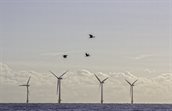Measuring with accuracy
From politicians to ecologists, concerned citizens to turbine manufacturers, a wide variety of people are eager to understand and mitigate bird casualties from wind turbines. But before the right solutions can be put into place, we must first understand the depth and breadth of the problem, and the factors that influence it. And for that, accurate data is essential.
WT Bird is the first system in the world that uses highly sensitive, optical fiber vibration sensors to detect a bird (or bat) collision with a turbine and distinguish it from ‘acoustic events', such as normal rotational noise, raindrops, or lightning strikes. The vibration sensors can measure the impact of an object not heavier than a few dozen grams on a turbine blade of several tonnes. With the help of thermal and visible spectrum cameras aimed at the wind turbine rotor, each collision can be studied and evaluated, and paired with data about weather patterns and other conditions to determine the circumstances around the collision. Only then can effective mitigation techniques be explored.
A boost for the (eco)system
Until now, those interested in collecting data about bird fatalities were limited to temporary observation techniques. But these could not register the exact timing and conditions of the collision and rely on extrapolation to compensate for the relatively short time frame and unknowns. This leads to inaccuracies. With WT Bird, scientists, ecologists, and legislators have verifiable proof of each collision and the conditions that contributed to it.
Broad-scale implementation of the WT Bird solution could have a significant impact on energy production, too. In some areas in which large flocks of birds predictably migrate, entire wind parks are shut down during migration periods to avoid the collision risk. However, there is no evidence that these measures are effective, or even necessary. With the information that WT Bird provides, better mitigation methods can be developed, making it possible to keep turbines rotating, thereby producing more carbon-neutral energy.
Proven technology
For more than 20 years, TNO has been investigating, evaluating, and improving the technology for effective measurements in this domain. After successful pilot projects in the Netherlands, the United States and Taiwan, WT Bird has been validated and is ready for implementation on a larger scale.
The technology has been tested in the harsh conditions of an offshore wind park in Taiwan. Physical monitoring around these turbines is far more limited, so reliable and long-term data about direct interaction with birds was nearly impossible before WT Bird. The TNO technology was able to withstand the typhoons, salty air and more unpredictable weather of offshore settings, and the significantly larger turbines of an offshore park, and continue to provide accurate and effective monitoring of bird collisions. The resulting data can easily be monitored from remote (onshore) workplaces, as the offshore server is connected to the internet, using the in-turbine data cabling and safe external data connections. Using only optical cables in the blade, the WT Bird system does not increase the risk of lightning strikes, as would have been the case if copper conductors were used in the cables.
What’s more, WT Bird is long-lasting and simple to maintain. Any required maintenance can be performed alongside regular turbine maintenance, and specialised technicians are not required.
Wide-scale application
Although installation in already-existing wind parks is possible, WT Bird is easiest to implement while turbines are being installed. And only wide-scale application of the technology can ensure the collection of enough data to provide conclusive evidence of the impact of turbines on various bird populations. So, while TNO is eager to speak with any partner interested in supporting implementation on a larger commercial scale, the technology is most suitable for suppliers to wind park developers or wind turbine manufacturers, as it is most convenient to combine the in-rotor sensor application with the construction of the blades. The commissioning of the WT Bird system along with the wind turbine commissioning is also most streamlined.
As more and more turbines are equipped with WT Bird technology, the essential data needed to understand and mitigate the risks of bird collisions can be collected and studied. And only then can effective and necessary mitigation techniques – and the legislation and regulation that it requires – be put into practice.
Could WT-bird technology benefit your market position? Contact us for investment and/or development opportunities.

